Researchers develop electronic skins that wirelessly activate fully soft robots
Robots in Depth with Anouk Wipprecht
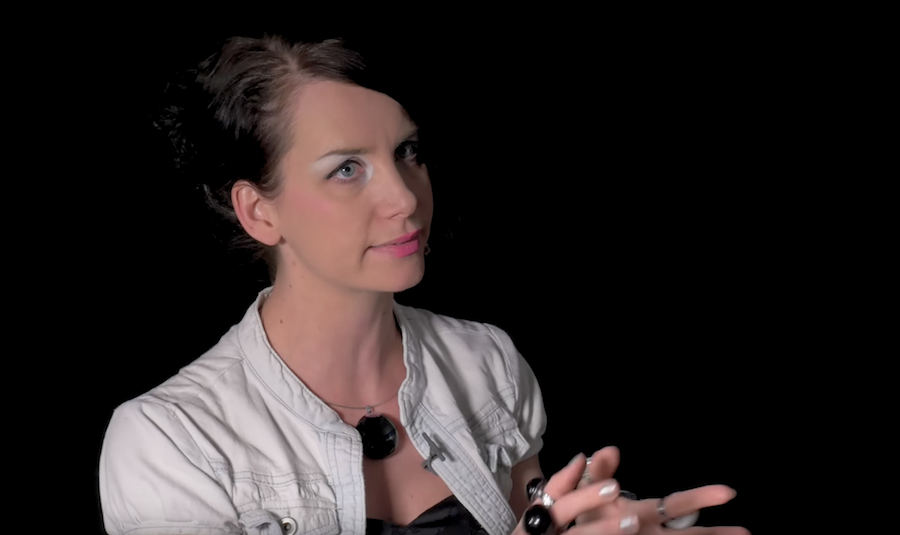 In this episode of Robots in Depth, Per Sjöborg speaks with Anouk Wipprecht, a Dutch FashionTech Designer who incorporates technology and robotics into fashion. She thinks that “Fashion lacks Microcontrollers”.
In this episode of Robots in Depth, Per Sjöborg speaks with Anouk Wipprecht, a Dutch FashionTech Designer who incorporates technology and robotics into fashion. She thinks that “Fashion lacks Microcontrollers”.
Anouk creates instinctual and behavioral wearables; essentially clothes that can sense, process and react. She creates dresses that move, including motors and special effects. They don´t follow the normal fashion cycle of becoming irrelevant after six months, since they can be updated, improved, and interacted with.
She is a big supporter of open source and is contributing an open source unicorn horn + cam design for children with ADHD amongst other things that she publishes on Instructables.com or Hackster.io.
Robots in Depth with Anouk Wipprecht
 In this episode of Robots in Depth, Per Sjöborg speaks with Anouk Wipprecht, a Dutch FashionTech Designer who incorporates technology and robotics into fashion. She thinks that “Fashion lacks Microcontrollers”.
In this episode of Robots in Depth, Per Sjöborg speaks with Anouk Wipprecht, a Dutch FashionTech Designer who incorporates technology and robotics into fashion. She thinks that “Fashion lacks Microcontrollers”.
Anouk creates instinctual and behavioral wearables; essentially clothes that can sense, process and react. She creates dresses that move, including motors and special effects. They don´t follow the normal fashion cycle of becoming irrelevant after six months, since they can be updated, improved, and interacted with.
She is a big supporter of open source and is contributing an open source unicorn horn + cam design for children with ADHD amongst other things that she publishes on Instructables.com or Hackster.io.
BDD100K: A large-scale diverse driving video database
By Fisher Yu
TL;DR, we released the largest and most diverse driving video dataset with richannotations called BDD100K. You can access the data for research now at http://bdd-data.berkeley.edu. We haverecently released an arXivreport on it. And there is still time to participate in our CVPR 2018 challenges!
Large-scale, Diverse, Driving, Video: Pick Four
Autonomous driving is poised to change the life in every community. However,recent events show that it is not clear yet how a man-made perception system canavoid even seemingly obvious mistakes when a driving system is deployed in thereal world. As computer vision researchers, we are interested in exploring thefrontiers of perception algorithms for self-driving to make it safer. To designand test potential algorithms, we would like to make use of all the informationfrom the data collected by a real driving platform. Such data has four majorproperties: it is large-scale, diverse, captured on the street, and withtemporal information. Data diversity is especially important to test therobustness of perception algorithms. However, current open datasets can onlycover a subset of the properties described above. Therefore, with the help of Nexar, we are releasing the BDD100Kdatabase, which is the largest and most diverse open driving video dataset sofar for computer vision research. This project is organized and sponsored by Berkeley DeepDrive IndustryConsortium, which investigates state-of-the-art technologies in computer visionand machine learning for automotive applications.

Locations of a random video subset.
As suggested in the name, our dataset consists of 100,000 videos. Each video isabout 40 seconds long, 720p, and 30 fps. The videos also come with GPS/IMUinformation recorded by cell-phones to show rough driving trajectories. Ourvideos were collected from diverse locations in the United States, as shown inthe figure above. Our database covers different weather conditions, includingsunny, overcast, and rainy, as well as different times of day including daytimeand nighttime. The table below summarizes comparisons with previous datasets,which shows our dataset is much larger and more diverse.
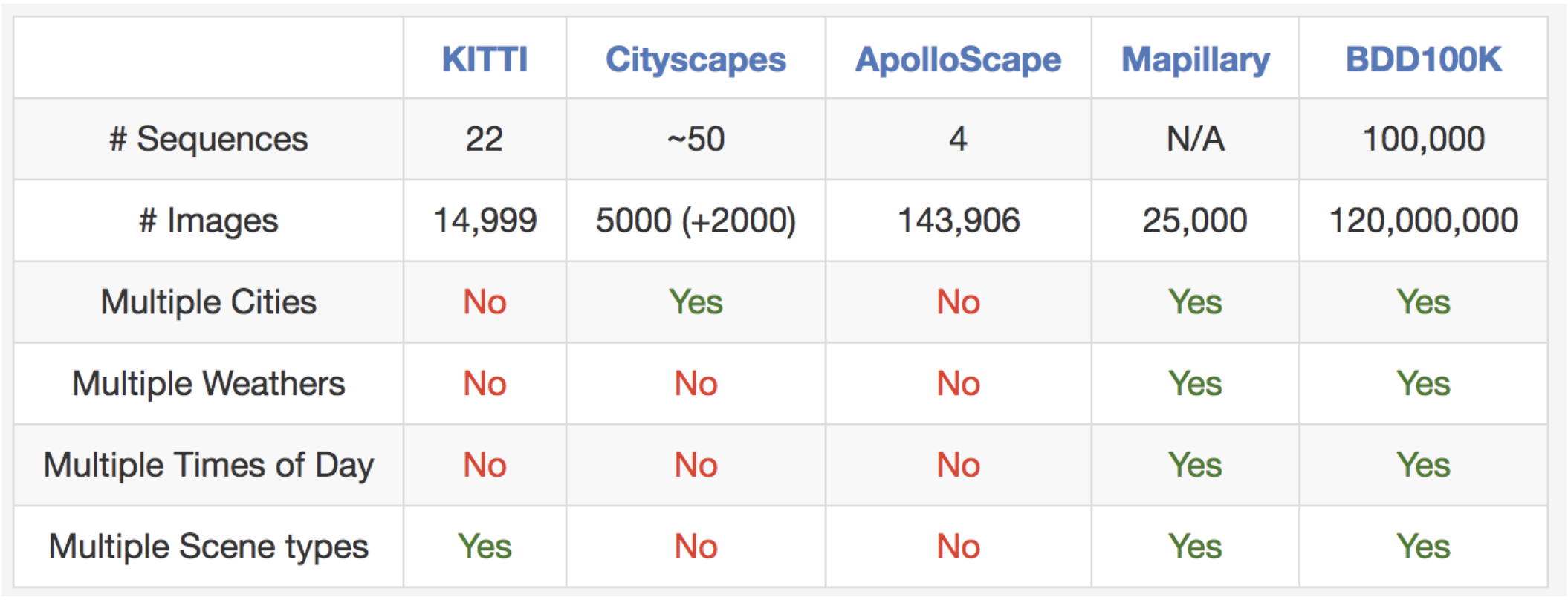
Comparisons with some other street scene datasets. It is hard to fairly compare# images between datasets, but we list them here as a rough reference.
The videos and their trajectories can be useful for imitation learning ofdriving policies, as in our CVPR 2017paper. To facilitate computer vision research on our large-scale dataset, wealso provide basic annotations on the video keyframes, as detailed in the nextsection. You can download the data and annotations now at http://bdd-data.berkeley.edu.
Annotations
We sample a keyframe at the 10th second from each video and provide annotationsfor those keyframes. They are labeled at several levels: image tagging, roadobject bounding boxes, drivable areas, lane markings, and full-frame instancesegmentation. These annotations will help us understand the diversity of thedata and object statistics in different types of scenes. We will discuss thelabeling process in a different blog post. More information about theannotations can be found in our arXivreport.
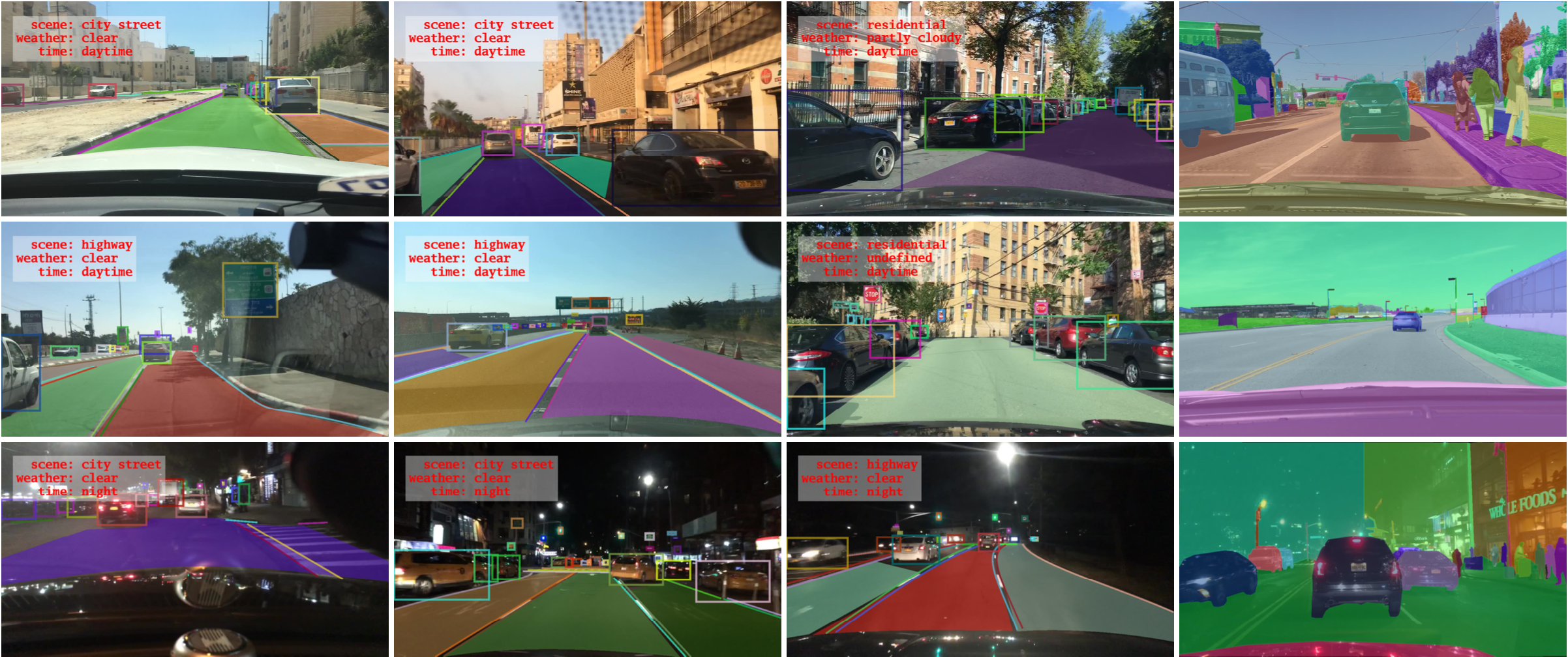
Overview of our annotations.
Road Object Detection
We label object bounding boxes for objects that commonly appear on the road onall of the 100,000 keyframes to understand the distribution of the objects andtheir locations. The bar chart below shows the object counts. There are alsoother ways to play with the statistics in our annotations. For example, we cancompare the object counts under different weather conditions or in differenttypes of scenes. This chart also shows the diverse set of objects that appear inour dataset, and the scale of our dataset – more than 1 million cars. Thereader should be reminded here that those are distinct objects with distinctappearances and contexts.

Statistics of different types of objects.
Our dataset is also suitable for studying some particular domains. For example,if you are interested in detecting and avoiding pedestrians on the streets, youalso have a reason to study our dataset since it contains more pedestrianinstances than previous specialized datasets as shown in the table below.

Comparisons with other pedestrian datasets regarding training set size.
Lane Markings
Lane markings are important road instructions for human drivers. They are alsocritical cues of driving direction and localization for the autonomous drivingsystems when GPS or maps does not have accurate global coverage. We divide thelane markings into two types based on how they instruct the vehicles in thelanes. Vertical lane markings (marked in red in the figures below) indicatemarkings that are along the driving direction of their lanes. Parallel lanemarkings (marked in blue in the figures below) indicate those that are for thevehicles in the lanes to stop. We also provide attributes for the markings suchas solid vs. dashed and double vs. single.
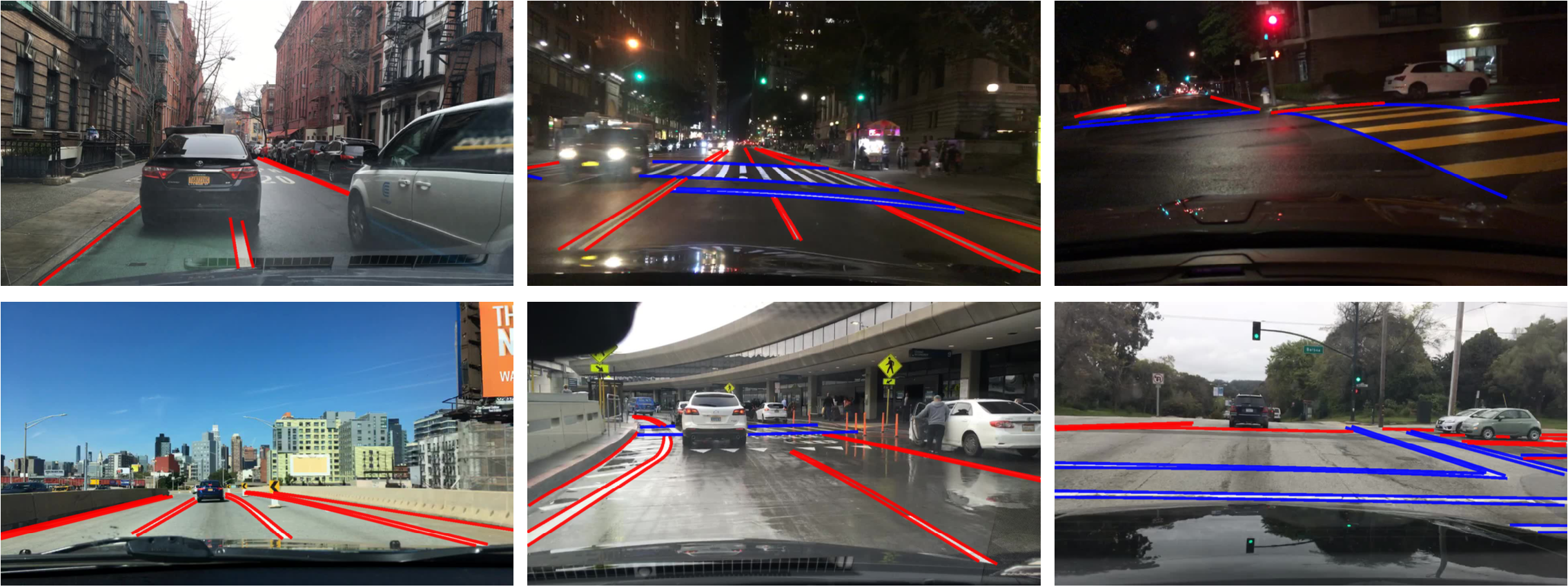
If you are ready to try out your lane marking prediction algorithms, please lookno further. Here is the comparison with existing lane marking datasets.

Drivable Areas
Whether we can drive on a road does not only depend on lane markings and trafficdevices. It also depends on the complicated interactions with other objectssharing the road. In the end, it is important to understand which area can bedriven on. To investigate this problem, we also provide segmentation annotationsof drivable areas as shown below. We divide the drivable areas into twocategories based on the trajectories of the ego vehicle: direct drivable, andalternative drivable. Direct drivable, marked in red, means the ego vehicle hasthe road priority and can keep driving in that area. Alternative drivable,marked in blue, means the ego vehicle can drive in the area, but has to becautious since the road priority potentially belongs to other vehicles.
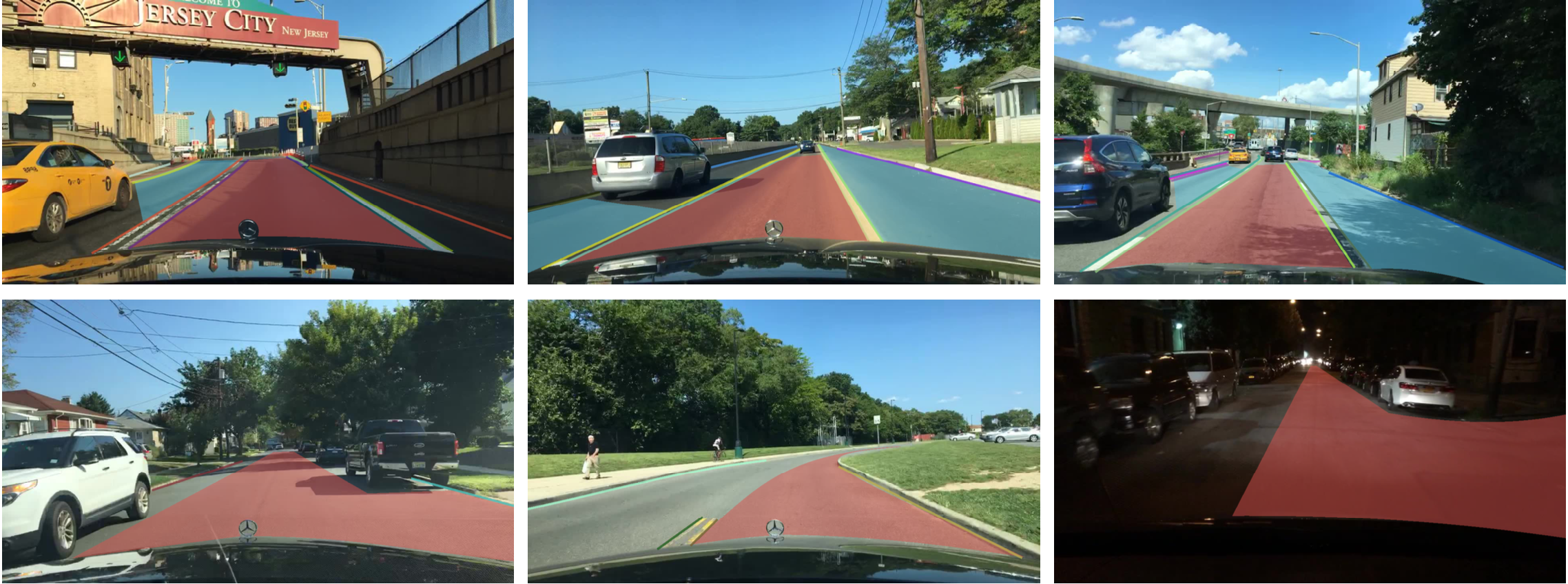
Full-frame Segmentation
It has been shown on Cityscapes dataset that full-frame fine instancesegmentation can greatly bolster research in dense prediction and objectdetection, which are pillars of a wide range of computer vision applications. Asour videos are in a different domain, we provide instance segmentationannotations as well to compare the domain shift relative by different datasets.It can be expensive and laborious to obtain full pixel-level segmentation.Fortunately, with our own labeling tool, the labeling cost could be reduced by50%. In the end, we label a subset of 10K images with full-frame instancesegmentation. Our label set is compatible with the training annotations inCityscapes to make it easier to study domain shift between the datasets.
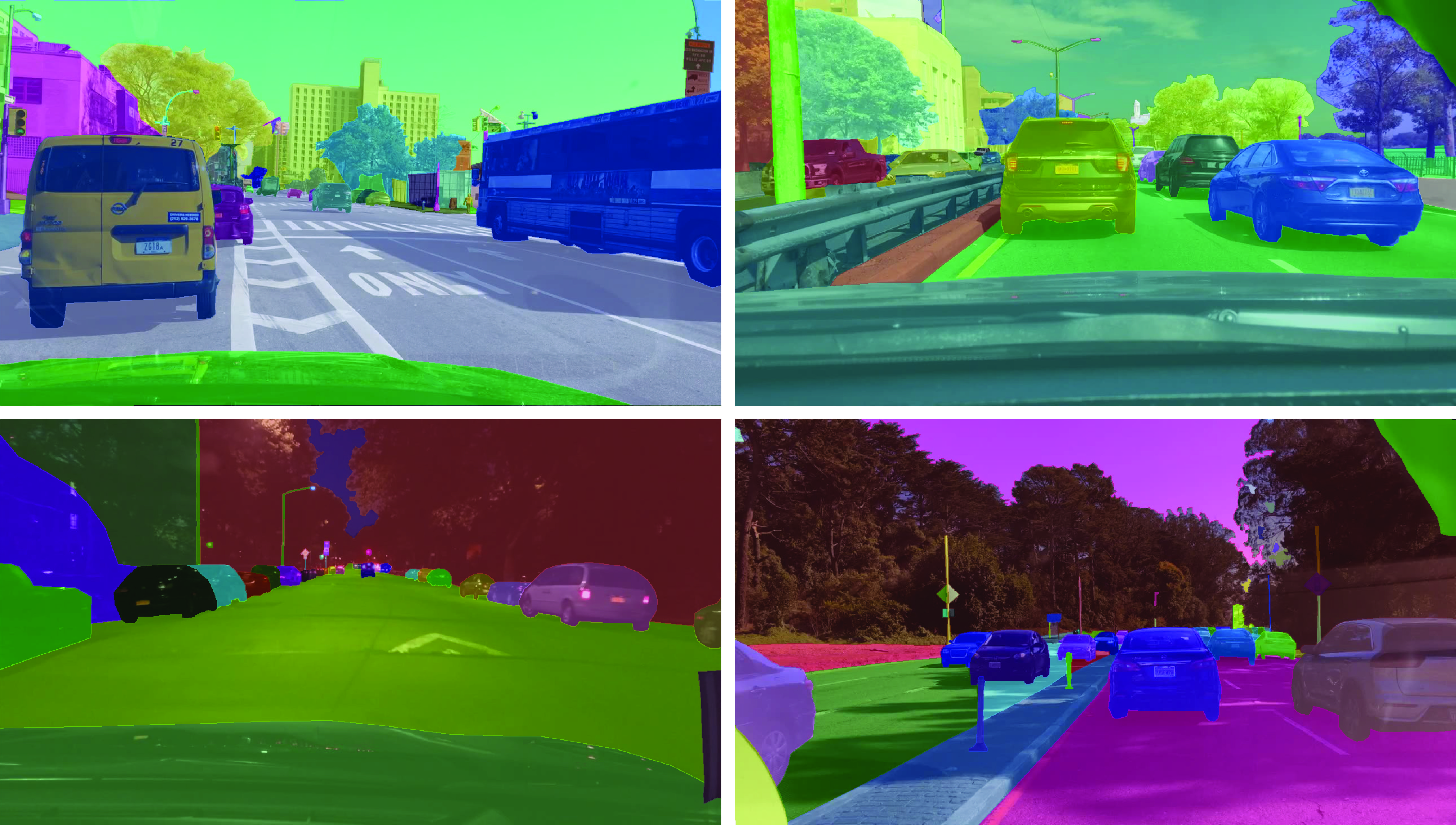
Driving Challenges
We are hosting threechallenges in CVPR 2018 Workshop on Autonomous Driving based on our data:road object detection, drivable area prediction, and domain adaptation ofsemantic segmentation. The detection task requires your algorithm to find all ofthe target objects in our testing images and drivable area prediction requiressegmenting the areas a car can drive in. In domain adaptation, the testing datais collected in China. Systems are thus challenged to get models learned in theUS to work in the crowded streets in Beijing, China. You can submit your resultsnow after logging in ouronline submission portal. Make sure to check out our toolkit to jump start yourparticipation.
Join our CVPR workshop challenges to claim your cash prizes!!!
Future Work
The perception system for self-driving is by no means only about monocularvideos. It may also include panorama and stereo videos as well as other typesof sensors like LiDAR and radar. We hope to provide and study thosemulti-modality sensor data as well in the near future.
Reference Links
Caltech, KITTI, CityPerson, Cityscapes, ApolloScape, Mapillary, Caltech Lanes Dataset, Road Marking Dataset, KITTI Road, VPGNet
This article was initially published on the BAIR blog, and appears here with the authors’ permission.
BDD100K: A large-scale diverse driving video database
By Fisher Yu
TL;DR, we released the largest and most diverse driving video dataset with richannotations called BDD100K. You can access the data for research now at http://bdd-data.berkeley.edu. We haverecently released an arXivreport on it. And there is still time to participate in our CVPR 2018 challenges!
Large-scale, Diverse, Driving, Video: Pick Four
Autonomous driving is poised to change the life in every community. However,recent events show that it is not clear yet how a man-made perception system canavoid even seemingly obvious mistakes when a driving system is deployed in thereal world. As computer vision researchers, we are interested in exploring thefrontiers of perception algorithms for self-driving to make it safer. To designand test potential algorithms, we would like to make use of all the informationfrom the data collected by a real driving platform. Such data has four majorproperties: it is large-scale, diverse, captured on the street, and withtemporal information. Data diversity is especially important to test therobustness of perception algorithms. However, current open datasets can onlycover a subset of the properties described above. Therefore, with the help of Nexar, we are releasing the BDD100Kdatabase, which is the largest and most diverse open driving video dataset sofar for computer vision research. This project is organized and sponsored by Berkeley DeepDrive IndustryConsortium, which investigates state-of-the-art technologies in computer visionand machine learning for automotive applications.

Locations of a random video subset.
As suggested in the name, our dataset consists of 100,000 videos. Each video isabout 40 seconds long, 720p, and 30 fps. The videos also come with GPS/IMUinformation recorded by cell-phones to show rough driving trajectories. Ourvideos were collected from diverse locations in the United States, as shown inthe figure above. Our database covers different weather conditions, includingsunny, overcast, and rainy, as well as different times of day including daytimeand nighttime. The table below summarizes comparisons with previous datasets,which shows our dataset is much larger and more diverse.

Comparisons with some other street scene datasets. It is hard to fairly compare# images between datasets, but we list them here as a rough reference.
The videos and their trajectories can be useful for imitation learning ofdriving policies, as in our CVPR 2017paper. To facilitate computer vision research on our large-scale dataset, wealso provide basic annotations on the video keyframes, as detailed in the nextsection. You can download the data and annotations now at http://bdd-data.berkeley.edu.
Annotations
We sample a keyframe at the 10th second from each video and provide annotationsfor those keyframes. They are labeled at several levels: image tagging, roadobject bounding boxes, drivable areas, lane markings, and full-frame instancesegmentation. These annotations will help us understand the diversity of thedata and object statistics in different types of scenes. We will discuss thelabeling process in a different blog post. More information about theannotations can be found in our arXivreport.

Overview of our annotations.
Road Object Detection
We label object bounding boxes for objects that commonly appear on the road onall of the 100,000 keyframes to understand the distribution of the objects andtheir locations. The bar chart below shows the object counts. There are alsoother ways to play with the statistics in our annotations. For example, we cancompare the object counts under different weather conditions or in differenttypes of scenes. This chart also shows the diverse set of objects that appear inour dataset, and the scale of our dataset – more than 1 million cars. Thereader should be reminded here that those are distinct objects with distinctappearances and contexts.

Statistics of different types of objects.
Our dataset is also suitable for studying some particular domains. For example,if you are interested in detecting and avoiding pedestrians on the streets, youalso have a reason to study our dataset since it contains more pedestrianinstances than previous specialized datasets as shown in the table below.

Comparisons with other pedestrian datasets regarding training set size.
Lane Markings
Lane markings are important road instructions for human drivers. They are alsocritical cues of driving direction and localization for the autonomous drivingsystems when GPS or maps does not have accurate global coverage. We divide thelane markings into two types based on how they instruct the vehicles in thelanes. Vertical lane markings (marked in red in the figures below) indicatemarkings that are along the driving direction of their lanes. Parallel lanemarkings (marked in blue in the figures below) indicate those that are for thevehicles in the lanes to stop. We also provide attributes for the markings suchas solid vs. dashed and double vs. single.

If you are ready to try out your lane marking prediction algorithms, please lookno further. Here is the comparison with existing lane marking datasets.

Drivable Areas
Whether we can drive on a road does not only depend on lane markings and trafficdevices. It also depends on the complicated interactions with other objectssharing the road. In the end, it is important to understand which area can bedriven on. To investigate this problem, we also provide segmentation annotationsof drivable areas as shown below. We divide the drivable areas into twocategories based on the trajectories of the ego vehicle: direct drivable, andalternative drivable. Direct drivable, marked in red, means the ego vehicle hasthe road priority and can keep driving in that area. Alternative drivable,marked in blue, means the ego vehicle can drive in the area, but has to becautious since the road priority potentially belongs to other vehicles.

Full-frame Segmentation
It has been shown on Cityscapes dataset that full-frame fine instancesegmentation can greatly bolster research in dense prediction and objectdetection, which are pillars of a wide range of computer vision applications. Asour videos are in a different domain, we provide instance segmentationannotations as well to compare the domain shift relative by different datasets.It can be expensive and laborious to obtain full pixel-level segmentation.Fortunately, with our own labeling tool, the labeling cost could be reduced by50%. In the end, we label a subset of 10K images with full-frame instancesegmentation. Our label set is compatible with the training annotations inCityscapes to make it easier to study domain shift between the datasets.

Driving Challenges
We are hosting threechallenges in CVPR 2018 Workshop on Autonomous Driving based on our data:road object detection, drivable area prediction, and domain adaptation ofsemantic segmentation. The detection task requires your algorithm to find all ofthe target objects in our testing images and drivable area prediction requiressegmenting the areas a car can drive in. In domain adaptation, the testing datais collected in China. Systems are thus challenged to get models learned in theUS to work in the crowded streets in Beijing, China. You can submit your resultsnow after logging in ouronline submission portal. Make sure to check out our toolkit to jump start yourparticipation.
Join our CVPR workshop challenges to claim your cash prizes!!!
Future Work
The perception system for self-driving is by no means only about monocularvideos. It may also include panorama and stereo videos as well as other typesof sensors like LiDAR and radar. We hope to provide and study thosemulti-modality sensor data as well in the near future.
Reference Links
Caltech, KITTI, CityPerson, Cityscapes, ApolloScape, Mapillary, Caltech Lanes Dataset, Road Marking Dataset, KITTI Road, VPGNet
This article was initially published on the BAIR blog, and appears here with the authors’ permission.
TDM: From model-free to model-based deep reinforcement learning
By Vitchyr Pong
You’ve decided that you want to bike from your house by UC Berkeley to the Golden Gate Bridge. It’s a nice 20 mile ride, but there’s a problem: you’ve never ridden a bike before!To make matters worse, you are new to the Bay Area, and all you have is a good ol’ fashion map to guide you. How do you get started? Let’s first figure out how to ride a bike. One strategy would be to do a lot of studying and planning. Read books on how to ride bicycles. Study physics and anatomy. Plan out all the different muscle movements that you’ll make in response to each perturbation. This approach is noble, but for anyone who’s ever learned to ride a bike, they know that this strategy is doomed to fail. There’s only one way to learn how to ride a bike: trial and error. Some tasks like riding a bike are just too complicated to plan out in your head. Once you’ve learned how to ride your bike, how would you get to the Golden Gate Bridge? You could reuse your trial-and-error strategy. Take a few random turns and see if you end up at the Golden Gate Bridge. Unfortunately, this strategy would take a very, very long time. For this sort of problem, planning is a much faster strategy, and requires considerably less real-world experience and trial-and-error. In reinforcement learning terms, it is more sample-efficient.
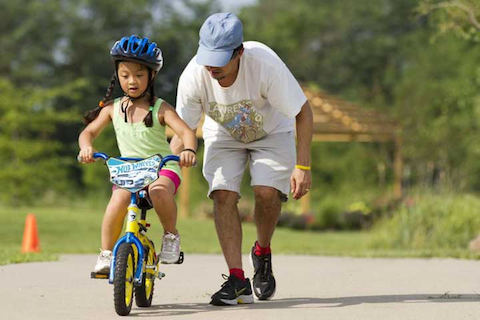 |
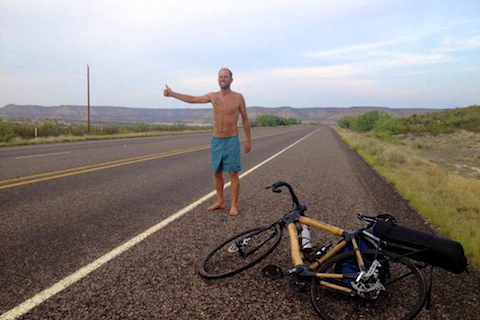 |
Left: some skills you learn by trial and error. Right: other times, planning ahead is better.
While simple, this thought experiment highlights some important aspects of human intelligence. For some tasks, we use a trial-and-error approach, and for others we use a planning approach. A similar phenomena seems to have emerged in reinforcement learning (RL). In the parlance of RL, empirical results show that some tasks are better suited for model-free (trial-and-error) approaches, and others are better suited for model-based (planning) approaches. However, the biking analogy also highlights that the two systems are not completely independent. In particularly, to say that learning to ride a bike is just trial-and-error is an oversimplification. In fact, when learning to bike by trial-and-error, you’ll employ a bit of planning. Perhaps your plan will initially be, “Don’t fall over.” As you improve, you’ll make more ambitious plans, such as, “Bike forwards for two meters without falling over.” Eventually, your bike-riding skills will be so proficient that you can start to plan in very abstract terms (“Bike to the end of the road.”) to the point that all there is left to do is planning and you no longer need to worry about the nitty-gritty details of riding a bike. We see that there is a gradual transition from the model-free (trial-and-error) strategy to a model-based (planning) strategy. If we could develop artificial intelligence algorithms–and specifically RL algorithms–that mimic this behavior, it could result in an algorithm that both performs well (by using trial-and-error methods early on) and is sample efficient (by later switching to a planning approach to achieve more abstract goals). This post covers temporal difference model (TDM), which is a RL algorithm that captures this smooth transition between model-free and model-based RL. Before describing TDMs, we start by first describing how a typical model-based RL algorithm works. Read More
TDM: From model-free to model-based deep reinforcement learning
By Vitchyr Pong
You’ve decided that you want to bike from your house by UC Berkeley to the Golden Gate Bridge. It’s a nice 20 mile ride, but there’s a problem: you’ve never ridden a bike before!To make matters worse, you are new to the Bay Area, and all you have is a good ol’ fashion map to guide you. How do you get started? Let’s first figure out how to ride a bike. One strategy would be to do a lot of studying and planning. Read books on how to ride bicycles. Study physics and anatomy. Plan out all the different muscle movements that you’ll make in response to each perturbation. This approach is noble, but for anyone who’s ever learned to ride a bike, they know that this strategy is doomed to fail. There’s only one way to learn how to ride a bike: trial and error. Some tasks like riding a bike are just too complicated to plan out in your head. Once you’ve learned how to ride your bike, how would you get to the Golden Gate Bridge? You could reuse your trial-and-error strategy. Take a few random turns and see if you end up at the Golden Gate Bridge. Unfortunately, this strategy would take a very, very long time. For this sort of problem, planning is a much faster strategy, and requires considerably less real-world experience and trial-and-error. In reinforcement learning terms, it is more sample-efficient.
 |
 |
Left: some skills you learn by trial and error. Right: other times, planning ahead is better.
While simple, this thought experiment highlights some important aspects of human intelligence. For some tasks, we use a trial-and-error approach, and for others we use a planning approach. A similar phenomena seems to have emerged in reinforcement learning (RL). In the parlance of RL, empirical results show that some tasks are better suited for model-free (trial-and-error) approaches, and others are better suited for model-based (planning) approaches. However, the biking analogy also highlights that the two systems are not completely independent. In particularly, to say that learning to ride a bike is just trial-and-error is an oversimplification. In fact, when learning to bike by trial-and-error, you’ll employ a bit of planning. Perhaps your plan will initially be, “Don’t fall over.” As you improve, you’ll make more ambitious plans, such as, “Bike forwards for two meters without falling over.” Eventually, your bike-riding skills will be so proficient that you can start to plan in very abstract terms (“Bike to the end of the road.”) to the point that all there is left to do is planning and you no longer need to worry about the nitty-gritty details of riding a bike. We see that there is a gradual transition from the model-free (trial-and-error) strategy to a model-based (planning) strategy. If we could develop artificial intelligence algorithms–and specifically RL algorithms–that mimic this behavior, it could result in an algorithm that both performs well (by using trial-and-error methods early on) and is sample efficient (by later switching to a planning approach to achieve more abstract goals). This post covers temporal difference model (TDM), which is a RL algorithm that captures this smooth transition between model-free and model-based RL. Before describing TDMs, we start by first describing how a typical model-based RL algorithm works. Read More
Teaching chores to an artificial agent
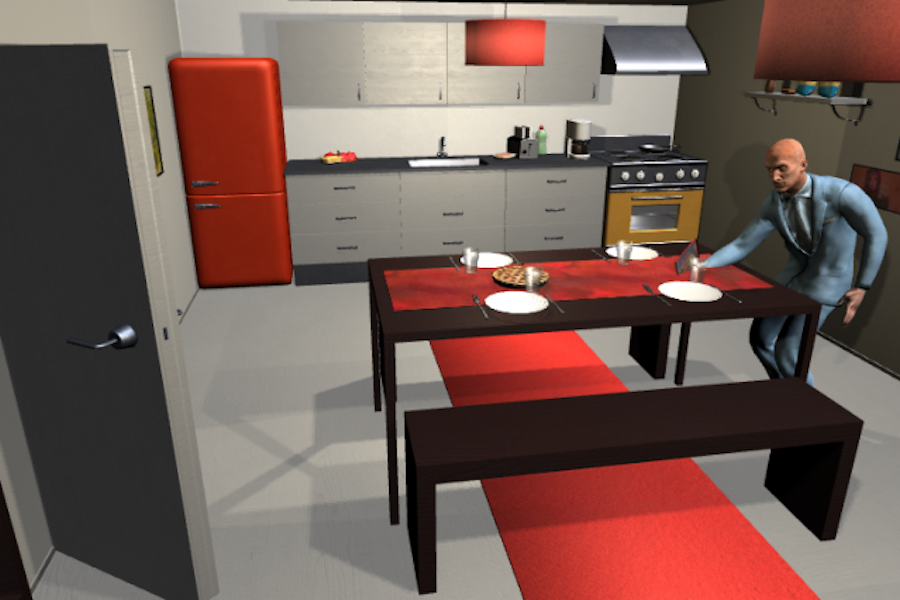
Image: MIT CSAIL
By Adam Conner-Simons | Rachel Gordon
For many people, household chores are a dreaded, inescapable part of life that we often put off or do with little care. But what if a robot assistant could help lighten the load?
Recently, computer scientists have been working on teaching machines to do a wider range of tasks around the house. In a new paper spearheaded by MIT’s Computer Science and Artificial Intelligence Laboratory (CSAIL) and the University of Toronto, researchers demonstrate “VirtualHome,” a system that can simulate detailed household tasks and then have artificial “agents” execute them, opening up the possibility of one day teaching robots to do such tasks.
The team trained the system using nearly 3,000 programs of various activities, which are further broken down into subtasks for the computer to understand. A simple task like “making coffee,” for example, would also include the step “grabbing a cup.” The researchers demonstrated VirtualHome in a 3-D world inspired by the Sims video game.
The team’s artificial agent can execute 1,000 of these interactions in the Sims-style world, with eight different scenes including a living room, kitchen, dining room, bedroom, and home office.
“Describing actions as computer programs has the advantage of providing clear and unambiguous descriptions of all the steps needed to complete a task,” says MIT PhD student Xavier Puig, who was lead author on the paper. “These programs can instruct a robot or a virtual character, and can also be used as a representation for complex tasks with simpler actions.”
The project was co-developed by CSAIL and the University of Toronto alongside researchers from McGill University and the University of Ljubljana. It will be presented at the Computer Vision and Pattern Recognition (CVPR) conference, which takes place this month in Salt Lake City.
Unlike humans, robots need more explicit instructions to complete easy tasks; they can’t just infer and reason with ease.
For example, one might tell a human to “switch on the TV and watch it from the sofa.” Here, actions like “grab the remote control” and “sit/lie on sofa” have been omitted, since they’re part of the commonsense knowledge that humans have.
To better demonstrate these kinds of tasks to robots, the descriptions for actions needed to be much more detailed. To do so, the team first collected verbal descriptions of household activities, and then translated them into simple code. A program like this might include steps like: walk to the television, switch on the television, walk to the sofa, sit on the sofa, and watch television.
Once the programs were created, the team fed them to the VirtualHome 3-D simulator to be turned into videos. Then, a virtual agent would execute the tasks defined by the programs, whether it was watching television, placing a pot on the stove, or turning a toaster on and off.
The end result is not just a system for training robots to do chores, but also a large database of household tasks described using natural language. Companies like Amazon that are working to develop Alexa-like robotic systems at home could eventually use data like these to train their models to do more complex tasks.
The team’s model successfully demonstrated that their agents could learn to reconstruct a program, and therefore perform a task, given either a description: “pour milk into glass” or a video demonstration of the activity.
“This line of work could facilitate true robotic personal assistants in the future,” says Qiao Wang, a research assistant in arts, media, and engineering at Arizona State University. “Instead of each task programmed by the manufacturer, the robot can learn tasks just by listening to or watching the specific person it accompanies. This allows the robot to do tasks in a personalized way, or even some day invoke an emotional connection as a result of this personalized learning process.”
In the future, the team hopes to train the robots using actual videos instead of Sims-style simulation videos, which would enable a robot to learn simply by watching a YouTube video. The team is also working on implementing a reward-learning system in which the agent gets positive feedback when it does tasks correctly.
“You can imagine a setting where robots are assisting with chores at home and can eventually anticipate personalized wants and needs, or impending action,” says Puig. “This could be especially helpful as an assistive technology for the elderly, or those who may have limited mobility.”
Teaching chores to an artificial agent

Image: MIT CSAIL
By Adam Conner-Simons | Rachel Gordon
For many people, household chores are a dreaded, inescapable part of life that we often put off or do with little care. But what if a robot assistant could help lighten the load?
Recently, computer scientists have been working on teaching machines to do a wider range of tasks around the house. In a new paper spearheaded by MIT’s Computer Science and Artificial Intelligence Laboratory (CSAIL) and the University of Toronto, researchers demonstrate “VirtualHome,” a system that can simulate detailed household tasks and then have artificial “agents” execute them, opening up the possibility of one day teaching robots to do such tasks.
The team trained the system using nearly 3,000 programs of various activities, which are further broken down into subtasks for the computer to understand. A simple task like “making coffee,” for example, would also include the step “grabbing a cup.” The researchers demonstrated VirtualHome in a 3-D world inspired by the Sims video game.
The team’s artificial agent can execute 1,000 of these interactions in the Sims-style world, with eight different scenes including a living room, kitchen, dining room, bedroom, and home office.
“Describing actions as computer programs has the advantage of providing clear and unambiguous descriptions of all the steps needed to complete a task,” says MIT PhD student Xavier Puig, who was lead author on the paper. “These programs can instruct a robot or a virtual character, and can also be used as a representation for complex tasks with simpler actions.”
The project was co-developed by CSAIL and the University of Toronto alongside researchers from McGill University and the University of Ljubljana. It will be presented at the Computer Vision and Pattern Recognition (CVPR) conference, which takes place this month in Salt Lake City.
Unlike humans, robots need more explicit instructions to complete easy tasks; they can’t just infer and reason with ease.
For example, one might tell a human to “switch on the TV and watch it from the sofa.” Here, actions like “grab the remote control” and “sit/lie on sofa” have been omitted, since they’re part of the commonsense knowledge that humans have.
To better demonstrate these kinds of tasks to robots, the descriptions for actions needed to be much more detailed. To do so, the team first collected verbal descriptions of household activities, and then translated them into simple code. A program like this might include steps like: walk to the television, switch on the television, walk to the sofa, sit on the sofa, and watch television.
Once the programs were created, the team fed them to the VirtualHome 3-D simulator to be turned into videos. Then, a virtual agent would execute the tasks defined by the programs, whether it was watching television, placing a pot on the stove, or turning a toaster on and off.
The end result is not just a system for training robots to do chores, but also a large database of household tasks described using natural language. Companies like Amazon that are working to develop Alexa-like robotic systems at home could eventually use data like these to train their models to do more complex tasks.
The team’s model successfully demonstrated that their agents could learn to reconstruct a program, and therefore perform a task, given either a description: “pour milk into glass” or a video demonstration of the activity.
“This line of work could facilitate true robotic personal assistants in the future,” says Qiao Wang, a research assistant in arts, media, and engineering at Arizona State University. “Instead of each task programmed by the manufacturer, the robot can learn tasks just by listening to or watching the specific person it accompanies. This allows the robot to do tasks in a personalized way, or even some day invoke an emotional connection as a result of this personalized learning process.”
In the future, the team hopes to train the robots using actual videos instead of Sims-style simulation videos, which would enable a robot to learn simply by watching a YouTube video. The team is also working on implementing a reward-learning system in which the agent gets positive feedback when it does tasks correctly.
“You can imagine a setting where robots are assisting with chores at home and can eventually anticipate personalized wants and needs, or impending action,” says Puig. “This could be especially helpful as an assistive technology for the elderly, or those who may have limited mobility.”
Surgical technique improves sensation, control of prosthetic limb
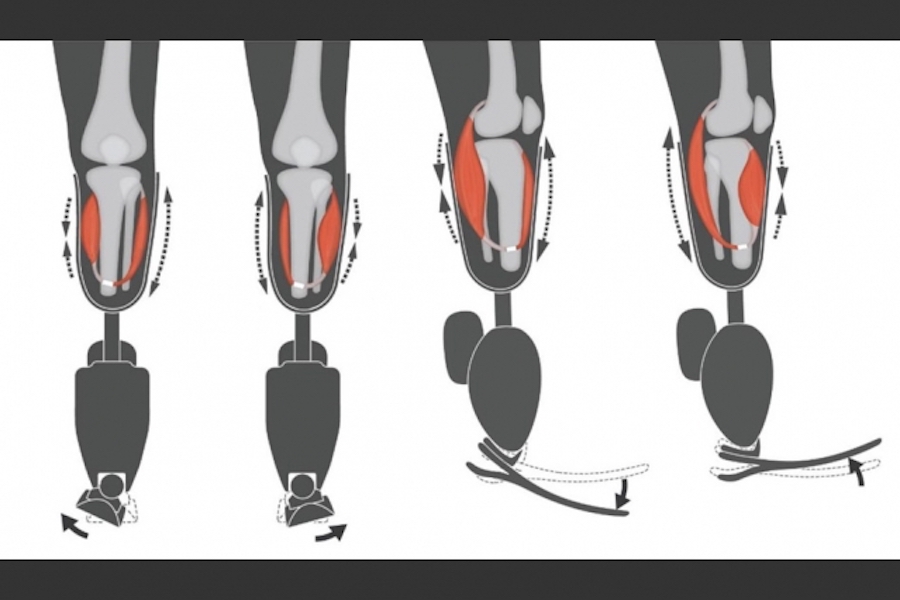
Image: MIT Media Lab/Biomechatronics group. Original artwork by Stephanie Ku.
By Helen Knight
Humans can accurately sense the position, speed, and torque of their limbs, even with their eyes shut. This sense, known as proprioception, allows humans to precisely control their body movements.
Despite significant improvements to prosthetic devices in recent years, researchers have been unable to provide this essential sensation to people with artificial limbs, limiting their ability to accurately control their movements.
Researchers at the Center for Extreme Bionics at the MIT Media Lab have invented a new neural interface and communication paradigm that is able to send movement commands from the central nervous system to a robotic prosthesis, and relay proprioceptive feedback describing movement of the joint back to the central nervous system in return.
This new paradigm, known as the agonist-antagonist myoneural interface, involves a novel surgical approach to limb amputation in which dynamic muscle relationships are preserved within the amputated limb. The AMI was validated in extensive preclinical experimentation at MIT prior to its first surgical implementation in a human patient at Brigham and Women’s Faulkner Hospital.

In a paper published today in Science Translational Medicine, the researchers describe the first human implementation of the agonist-antagonist myoneural interface (AMI), in a person with below-knee amputation.
The paper represents the first time information on joint position, speed, and torque has been fed from a prosthetic limb into the nervous system, according to senior author and project director Hugh Herr, a professor of media arts and sciences at the MIT Media Lab.
“Our goal is to close the loop between the peripheral nervous system’s muscles and nerves, and the bionic appendage,” says Herr.
To do this, the researchers used the same biological sensors that create the body’s natural proprioceptive sensations.
The AMI consists of two opposing muscle-tendons, known as an agonist and an antagonist, which are surgically connected in series so that when one muscle contracts and shortens — upon either volitional or electrical activation — the other stretches, and vice versa.

This coupled movement enables natural biological sensors within the muscle-tendon to transmit electrical signals to the central nervous system, communicating muscle length, speed, and force information, which is interpreted by the brain as natural joint proprioception.
This is how muscle-tendon proprioception works naturally in human joints, Herr says.
“Because the muscles have a natural nerve supply, when this agonist-antagonist muscle movement occurs information is sent through the nerve to the brain, enabling the person to feel those muscles moving, both their position, speed, and load,” he says.
By connecting the AMI with electrodes, the researchers can detect electrical pulses from the muscle, or apply electricity to the muscle to cause it to contract.
“When a person is thinking about moving their phantom ankle, the AMI that maps to that bionic ankle is moving back and forth, sending signals through the nerves to the brain, enabling the person with an amputation to actually feel their bionic ankle moving throughout the whole angular range,” Herr says.
Decoding the electrical language of proprioception within nerves is extremely difficult, according to Tyler Clites, first author of the paper and graduate student lead on the project.
“Using this approach, rather than needing to speak that electrical language ourselves, we use these biological sensors to speak the language for us,” Clites says. “These sensors translate mechanical stretch into electrical signals that can be interpreted by the brain as sensations of position, speed, and force.”
The AMI was first implemented surgically in a human patient at Brigham and Women’s Faulkner Hospital, Boston, by Matthew Carty, one of the paper’s authors, a surgeon in the Division of Plastic and Reconstructive Surgery, and an MIT research scientist.
In this operation, two AMIs were constructed in the residual limb at the time of primary below-knee amputation, with one AMI to control the prosthetic ankle joint, and the other to control the prosthetic subtalar joint.
“We knew that in order for us to validate the success of this new approach to amputation, we would need to couple the procedure with a novel prosthesis that could take advantage of the additional capabilities of this new type of residual limb,” Carty says. “Collaboration was critical, as the design of the procedure informed the design of the robotic limb, and vice versa.”
Toward this end, an advanced prosthetic limb was built at MIT and electrically linked to the patient’s peripheral nervous system using electrodes placed over each AMI muscle following the amputation surgery.
The researchers then compared the movement of the AMI patient with that of four people who had undergone a traditional below-knee amputation procedure, using the same advanced prosthetic limb.
They found that the AMI patient had more stable control over movement of the prosthetic device and was able to move more efficiently than those with the conventional amputation. They also found that the AMI patient quickly displayed natural, reflexive behaviors such as extending the toes toward the next step when walking down a set of stairs.
These behaviors are essential to natural human movement and were absent in all of the people who had undergone a traditional amputation.
What’s more, while the patients with conventional amputation reported feeling disconnected to the prosthesis, the AMI patient quickly described feeling that the bionic ankle and foot had become a part of their own body.
“This is pretty significant evidence that the brain and the spinal cord in this patient adopted the prosthetic leg as if it were their biological limb, enabling those biological pathways to become active once again,” Clites says. “We believe proprioception is fundamental to that adoption.”
It is difficult for an individual with a lower limb amputation to gain a sense of embodiment with their artificial limb, according to Daniel Ferris, the Robert W. Adenbaum Professor of Engineering Innovation at the University of Florida, who was not involved in the research.
“This is ground breaking. The increased sense of embodiment by the amputee subject is a powerful result of having better control of and feedback from the bionic limb,” Ferris says. “I expect that we will see individuals with traumatic amputations start to seek out this type of surgery and interface for their prostheses — it could provide a much greater quality of life for amputees.”
The researchers have since carried out the AMI procedure on nine other below-knee amputees and are planning to adapt the technique for those needing above-knee, below-elbow, and above-elbow amputations.
“Previously, humans have used technology in a tool-like fashion,” Herr says. “We are now starting to see a new era of human-device interaction, of full neurological embodiment, in which what we design becomes truly part of us, part of our identity.”
Surgical technique improves sensation, control of prosthetic limb

Image: MIT Media Lab/Biomechatronics group. Original artwork by Stephanie Ku.
By Helen Knight
Humans can accurately sense the position, speed, and torque of their limbs, even with their eyes shut. This sense, known as proprioception, allows humans to precisely control their body movements.
Despite significant improvements to prosthetic devices in recent years, researchers have been unable to provide this essential sensation to people with artificial limbs, limiting their ability to accurately control their movements.
Researchers at the Center for Extreme Bionics at the MIT Media Lab have invented a new neural interface and communication paradigm that is able to send movement commands from the central nervous system to a robotic prosthesis, and relay proprioceptive feedback describing movement of the joint back to the central nervous system in return.
This new paradigm, known as the agonist-antagonist myoneural interface, involves a novel surgical approach to limb amputation in which dynamic muscle relationships are preserved within the amputated limb. The AMI was validated in extensive preclinical experimentation at MIT prior to its first surgical implementation in a human patient at Brigham and Women’s Faulkner Hospital.

In a paper published today in Science Translational Medicine, the researchers describe the first human implementation of the agonist-antagonist myoneural interface (AMI), in a person with below-knee amputation.
The paper represents the first time information on joint position, speed, and torque has been fed from a prosthetic limb into the nervous system, according to senior author and project director Hugh Herr, a professor of media arts and sciences at the MIT Media Lab.
“Our goal is to close the loop between the peripheral nervous system’s muscles and nerves, and the bionic appendage,” says Herr.
To do this, the researchers used the same biological sensors that create the body’s natural proprioceptive sensations.
The AMI consists of two opposing muscle-tendons, known as an agonist and an antagonist, which are surgically connected in series so that when one muscle contracts and shortens — upon either volitional or electrical activation — the other stretches, and vice versa.

This coupled movement enables natural biological sensors within the muscle-tendon to transmit electrical signals to the central nervous system, communicating muscle length, speed, and force information, which is interpreted by the brain as natural joint proprioception.
This is how muscle-tendon proprioception works naturally in human joints, Herr says.
“Because the muscles have a natural nerve supply, when this agonist-antagonist muscle movement occurs information is sent through the nerve to the brain, enabling the person to feel those muscles moving, both their position, speed, and load,” he says.
By connecting the AMI with electrodes, the researchers can detect electrical pulses from the muscle, or apply electricity to the muscle to cause it to contract.
“When a person is thinking about moving their phantom ankle, the AMI that maps to that bionic ankle is moving back and forth, sending signals through the nerves to the brain, enabling the person with an amputation to actually feel their bionic ankle moving throughout the whole angular range,” Herr says.
Decoding the electrical language of proprioception within nerves is extremely difficult, according to Tyler Clites, first author of the paper and graduate student lead on the project.
“Using this approach, rather than needing to speak that electrical language ourselves, we use these biological sensors to speak the language for us,” Clites says. “These sensors translate mechanical stretch into electrical signals that can be interpreted by the brain as sensations of position, speed, and force.”
The AMI was first implemented surgically in a human patient at Brigham and Women’s Faulkner Hospital, Boston, by Matthew Carty, one of the paper’s authors, a surgeon in the Division of Plastic and Reconstructive Surgery, and an MIT research scientist.
In this operation, two AMIs were constructed in the residual limb at the time of primary below-knee amputation, with one AMI to control the prosthetic ankle joint, and the other to control the prosthetic subtalar joint.
“We knew that in order for us to validate the success of this new approach to amputation, we would need to couple the procedure with a novel prosthesis that could take advantage of the additional capabilities of this new type of residual limb,” Carty says. “Collaboration was critical, as the design of the procedure informed the design of the robotic limb, and vice versa.”
Toward this end, an advanced prosthetic limb was built at MIT and electrically linked to the patient’s peripheral nervous system using electrodes placed over each AMI muscle following the amputation surgery.
The researchers then compared the movement of the AMI patient with that of four people who had undergone a traditional below-knee amputation procedure, using the same advanced prosthetic limb.
They found that the AMI patient had more stable control over movement of the prosthetic device and was able to move more efficiently than those with the conventional amputation. They also found that the AMI patient quickly displayed natural, reflexive behaviors such as extending the toes toward the next step when walking down a set of stairs.
These behaviors are essential to natural human movement and were absent in all of the people who had undergone a traditional amputation.
What’s more, while the patients with conventional amputation reported feeling disconnected to the prosthesis, the AMI patient quickly described feeling that the bionic ankle and foot had become a part of their own body.
“This is pretty significant evidence that the brain and the spinal cord in this patient adopted the prosthetic leg as if it were their biological limb, enabling those biological pathways to become active once again,” Clites says. “We believe proprioception is fundamental to that adoption.”
It is difficult for an individual with a lower limb amputation to gain a sense of embodiment with their artificial limb, according to Daniel Ferris, the Robert W. Adenbaum Professor of Engineering Innovation at the University of Florida, who was not involved in the research.
“This is ground breaking. The increased sense of embodiment by the amputee subject is a powerful result of having better control of and feedback from the bionic limb,” Ferris says. “I expect that we will see individuals with traumatic amputations start to seek out this type of surgery and interface for their prostheses — it could provide a much greater quality of life for amputees.”
The researchers have since carried out the AMI procedure on nine other below-knee amputees and are planning to adapt the technique for those needing above-knee, below-elbow, and above-elbow amputations.
“Previously, humans have used technology in a tool-like fashion,” Herr says. “We are now starting to see a new era of human-device interaction, of full neurological embodiment, in which what we design becomes truly part of us, part of our identity.”
Automating window washing
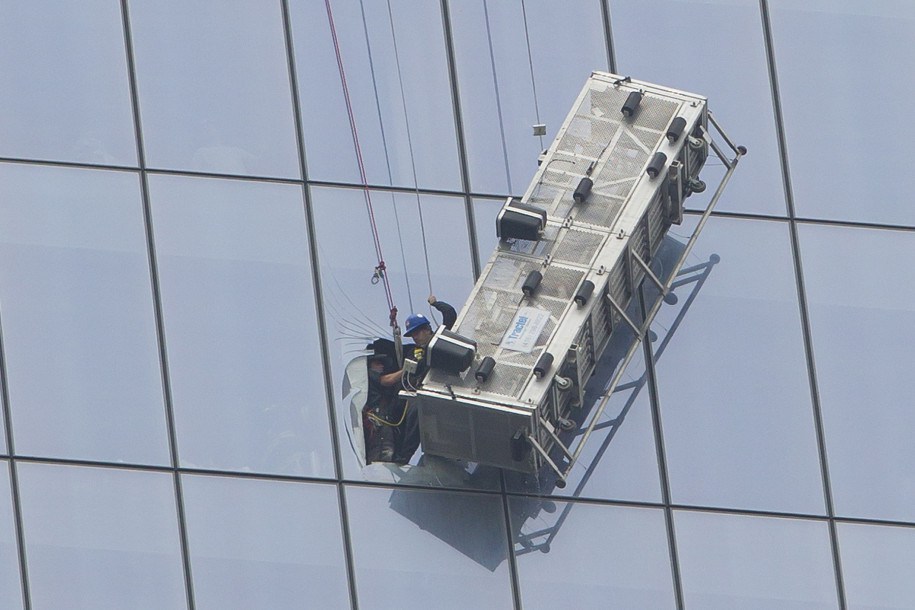
Three and half years ago, I stood on the corner of West Street and gasped as two window washers clung to life at the end of a rope a thousand feet above. By the time rescue crews reached the men on the 69th floor of 1 World Trade they were close to passing out from dangling upside down. Everyday risk-taking men and women hook their bodies to metal scaffolds and ascend to deadly heights for $25 an hour. Ramone Castro, a window washer of three decades, said it best, “It is a very dangerous job. It is not easy going up there. You can replace a machine but not a life.” Castro’s statement sounds like an urgent call to action for robots.
One of the promises of automation is replacing tasks that are too dangerous for humans. Switzerland-based Serbot believes that high-rise facade cleaning is one of those jobs ripe for disruption. In 2010, it was first reported that Serbot contracted with the city of Dubai to automatically clean its massive glass skyline. Utilizing their GEKKO machine, the Swiss company has demonstrated a performance of over 400 square meters an hour, 15 times faster than a professional washer. GEKKO leverages a unique suction technology that enables the massive Roomba-like device to be suspended from the roof and adhere to the curtain wall regardless of weather conditions or architectural features. Serbot offers both semi and full autonomous versions of its GEKKOs, which include options for retrofitting existing roof systems. It is unclear how many robots are actually deployed in the marketplace, however Serbot recently announced the cleaning of the architecturally challenging FESTO’s Automation Center in Germany (shown below).

According to the press release, “The entire building envelope is cleaned automatically: by a robot, called GEKKO Facade, which sucks on the glass facade. This eliminates important disadvantages of conventional cleaning: no disturbance of the user by cleaning personnel, no risky working in a gondola at high altitude, no additional protection during the cleaning phase, etc.” Serbot further states its autonomous system was able to work at amazing speeds cleaning the 8,600 square meter structure within a couple of days via its intelligent platform that plans a route across the entire glass facade.

Parallel to the global trend of urbanization, skyscraper construction is at an all time high. Demand for glass facade materials and maintenance services is close to surpassing $200 billion worldwide. As New York City is in the center of the construction boom, Israeli-startup, Skyline Robotics, recently joined Iconic Labs NYC (ICONYC). This week, I had the opportunity to ask Skyline founder and CEO Yaron Schwarcz about the move. Schwarcz proudly said, “So far we are deployed in Israel only and are working exclusively with one of the top 5 cleaning companies. Joining ICONYC was definitely a step forward, as a rule we only move forward, we believe that ICONIC can and will help us connect with the best investors and help us grow in the NY market.”
While Serbot requires building owners to purchase their proprietary suction cleaning system, Skyline’s machine, called Ozmo, integrates seamlessly with existing equipment. Schwarcz explains, “We use the existing scaffold of the building in contrast to GEKKO’s use of suction. The use of the arms is to copy the human arms which is the only way to fully maintain the entire building and all its complexity. The Ozmo system is not only a window cleaner, it’s a platform for all types of facade maintenance. Ozmo does not need any humans on the rig, never putting people in danger.” Schwarcz further shared with me the results of early case studies in Israel whereby Ozmo cleaned an entire vertical glass building in 80 hours with one supervisor remotely controlling the operation from the ground, adding with “no breaks.”
While Serbot and Skyline offer an optimistic view of the future, past efforts have been met with skepticism. In a 2014 New York Times article, written days after the two window washers almost fell to their deaths, the paper concluded, “washing windows is something that machines still cannot do as well.” The Times interviewed building exterior consultant, Craig S. Caulkins, who stated then, “Robots have problems.” Caulkins says the set back for automation has been the quality of work, citing numerous examples of dirty window corners. “If you are a fastidious owner wanting clean, clean windows so you can take advantage of that very expensive view that you bought, the last thing you want to see is that gray area around the rim of the window,” exclaimed Caulkins. Furthermore, New York City’s window washers are represented by a very active labor union, S.E.I.U. Local 32BJ. The fear of robots replacing their members could lead to city wide protests, and strikes. The S.E.I.U. 32BJ press office did not return calls for comment.
High rise window washing in New York is very much part of the folklore of the Big Apple. One of the best selling local children books, “Window Washer: At Work Above the Clouds,” profiles the former Twin Towers cleaner Roko Camaj. In 1995, Camaj predicted that “Ten years from now, all window washing will probably be done by a machine.” Unfortunately, Camaj never lived to see the innovations of GEKKO and Ozmo, as he perished in the Towers on September the 11th.

Automating high-risk professions will be explored further on June 13th @ 6pm in NYC with Democratic Presidential Candidate Andrew Yang and New York Assemblyman Clyde Vanel at the next RobotLab on “The Politics Of Automation” – Reserve Today!